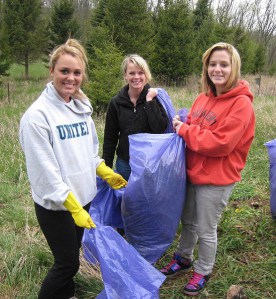
This spring at Grass Lake Sanctuary, the trilliums, spring beauties, dog tooth violets and other native plants will have more room to grow thanks to an ongoing conservation project on the land. Conservation Steward Lana Jerome and volunteers have been working hard for the last three years to remove garlic mustard from Grass Lake Sanctuary.
Garlic mustard, which originated in Europe and was brought to Michigan with the settlers, is classified as an invasive species. In our Midwest ecosystem, it has no natural limiters. No animals use it for food and it competes with native plants for sunlight and soil nutrients. It reproduces rapidly and forces out other plants, creating less diversity in the ecosystem. This lack of diversity in turn affects animals and insects who depend on the native plants. Midwest Invasive Plants Network is a good resource for learning more about invasive species.
Removing garlic mustard is truly a labor of love for those who participate in the Grass Lake Sanctuary conservation project. Volunteers hand pull the plants one by one before they produce seeds. They covered over 30 acres and pulled 4500 lbs of garlic mustard during the first year of the project. Volunteer Tamara Wendt explained the scope saying, “I looked around and realized I was weeding a whole forest.”
Volunteering isn’t just all hard work though. Lana Jerome spoke about the experience of volunteering. “It is an opportunity to get to know the land intimately.” Many volunteers have bonded with the land and each other as they worked together pulling bags and bags of garlic mustard. Volunteers have also found ways to keep it humorous — one summer featured a garlic mustard pesto recipe contest.
The conservation project has also created opportunities for many different groups from the community to come volunteer and experience the gifts of Grass Lake Sanctuary, including children from the Rudolf Steiner School of Ann Arbor, local families, REI employees and customers, Eagle Scouts, Boy Scouts and Cub Scouts. During one day of removing invasive species, a young Cub Scout excitedly ran up to Lana and said, “The land can breathe again.” That simple statement shows the palpable connection to the land that develops as people work at the sanctuary. On another volunteer day, a grandmother brought her grandchildren out to participate. It turned out to be a cold, rainy day, but the kids were still so excited — the weather could not dampen their enthusiasm. They put on garbage bags over their clothes to keep dry and went out to help pull up the plants. They may have pulled less than half a bag of garlic mustard, but their excitement and eagerness to help was joyful to watch.
